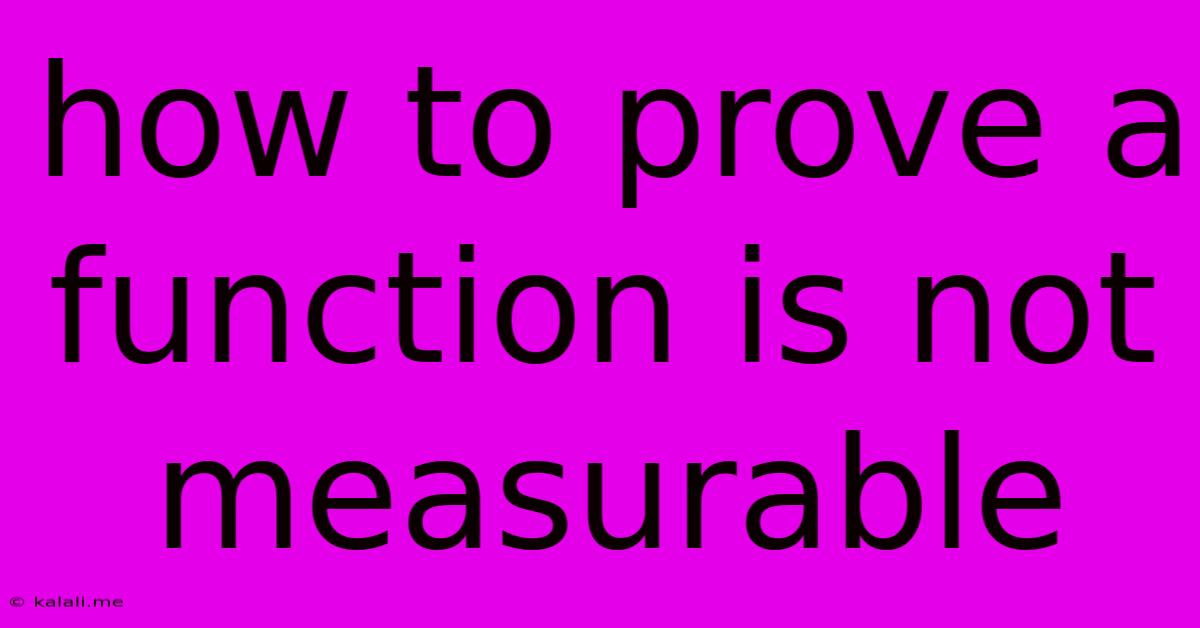How To Prove A Function Is Not Measurable
Kalali
May 23, 2025 · 3 min read

Table of Contents
How to Prove a Function is Non-Measurable: A Guide for Mathematicians
This article delves into the fascinating, and sometimes challenging, world of measure theory. Specifically, we'll explore different methods for proving a function is not measurable. Understanding non-measurability is crucial for a deeper comprehension of measure theory and its applications in various fields like probability and analysis. This guide will equip you with the necessary tools and techniques to tackle such proofs.
What is a Measurable Function?
Before diving into proving non-measurability, let's briefly recap the definition. Given two measurable spaces (X, Σ) and (Y, Τ), a function f: X → Y is measurable if the preimage of every measurable set in Y is a measurable set in X. Formally: for every E ∈ Τ, f⁻¹(E) ∈ Σ. This seemingly simple definition holds significant implications.
Methods for Proving Non-Measurability
Proving a function is not measurable involves demonstrating that the condition above is violated. This often requires leveraging the properties of measurable sets and the specific characteristics of the function in question. Here are some key strategies:
1. Constructing a Non-Measurable Preimage
This is arguably the most straightforward method. You aim to find a measurable set E in the codomain (Y, Τ) such that its preimage under f, f⁻¹(E), is not measurable in the domain (X, Σ). This directly contradicts the definition of measurability.
- Example: Consider a function f mapping from a non-measurable subset of the real numbers to the real numbers. If you choose E to be a simple measurable set like an interval, and you can demonstrate that f⁻¹(E) is the non-measurable set you started with, you've proven f is non-measurable. This method relies on the existence of non-measurable sets, a fundamental concept in measure theory.
2. Exploiting Properties of Measurable Functions
Measurable functions possess certain properties. If a function violates any of these properties, it cannot be measurable. Some key properties include:
- Closure under Composition: The composition of two measurable functions is measurable. If you can express your function as a composition where at least one component is non-measurable, the entire function is non-measurable.
- Preservation of Measurability: Measurable functions preserve certain set properties under preimages. For example, the preimage of a null set is a null set. Showing a violation of such preservation indicates non-measurability.
- Relationship with Borel Sets: In many cases, functions defined on the real numbers interact with the Borel σ-algebra. Using the properties of Borel sets can provide powerful tools to disprove measurability. For example, you can leverage the fact that Borel sets are countable unions of intervals.
3. Using the Vitali Set (or similar constructions)**
The Vitali set is a classic example of a non-measurable set. Its construction leverages the Axiom of Choice. Functions whose preimages are related to the Vitali set are frequently non-measurable. This approach often involves partitioning the real numbers and demonstrating a contradiction through cardinality arguments.
Practical Tips and Considerations
- Understanding the underlying measure spaces: The specific measure spaces involved significantly impact the proof strategy. The choice of σ-algebra is crucial.
- Leveraging set theoretic arguments: Proving non-measurability often involves demonstrating contradictions using set theory principles, such as cardinality arguments or exploiting the properties of σ-algebras.
- Careful consideration of the function's properties: Analyzing the function's behavior, especially near discontinuities or on specific subsets of the domain, is vital.
Proving a function is non-measurable can be more challenging than proving measurability. However, by carefully applying the strategies outlined above and understanding the fundamental concepts of measure theory, you can effectively tackle such problems. Remember to clearly state your assumptions, define your terms precisely, and systematically demonstrate the violation of the measurability condition.
Latest Posts
Latest Posts
-
Magento 2 Create A Js To Extend Shipping Js
May 23, 2025
-
What Is The Eigenvector For Identity Matrix
May 23, 2025
-
Graphql Using And In Where Clause Lwc Example
May 23, 2025
-
Data In Ml Upper Superscript Sample Or Dimension
May 23, 2025
-
And Then She Went To Work
May 23, 2025
Related Post
Thank you for visiting our website which covers about How To Prove A Function Is Not Measurable . We hope the information provided has been useful to you. Feel free to contact us if you have any questions or need further assistance. See you next time and don't miss to bookmark.